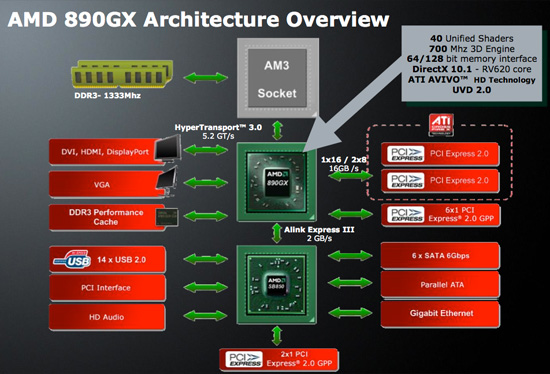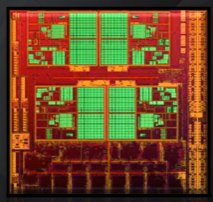AMD's 890GX Chipset - Same Graphics, Better South Bridge
by Anand Lal Shimpi on March 2, 2010 4:36 AM EST- Posted in
- CPUs
No news isn’t always good news. AMD has been purposefully vague on the graphics specifications of its 8-series chipsets. Today we know why. The AMD 890GX has the exact same graphics horsepower as the 790GX:
| AMD 890GX | AMD 790GX | AMD 785G | |
| CPU | AMD Socket-AM3 | AMD Socket-AM3/AM2+ | AMD Socket-AM3/AM2+ |
| Manufacturing Process | 55nm | 55nm | 55nm |
| PCI Express | 24 PCIe 2.0 lanes | 22 PCIe 2.0 lanes | 22 PCIe 2.0 lanes |
| Graphics | Radeon HD 4290 (DirectX 10.1) | Radeon HD 3300 (DirectX 10.0) | Radeon HD 4200 (DirectX 10.1) |
| Core Clock | 700MHz | 700MHz | 500MHz |
| Shader Processors | 8 (5-way) | 8 (5-way) | |
| Full H.264/VC-1/MPEG-2 HW Decode | Yes (UVD2) | Yes (UVD) | Yes (UVD2) |
| 8-channel LPCM | No | No | No |
| South Bridge | SB850 | SB750 | SB750 |
| USB | 14 USB 2.0 ports | 12 USB 2.0 ports | 12 USB 2.0 ports |
| SATA | 6 SATA 6Gbps ports | 6 SATA 3Gbps ports | 6 SATA 3Gbps ports |
In fact, it’s virtually the same graphics core as the 790GX and 785G built on the same 55nm process.

AMD 890GX North Bridge (left) vs. AMD 790GX North Bridge (right) - nothing has changed

SidePort memory on a motherboard
For those of you who aren’t familiar with AMD’s integrated graphics, it’s a 40 SP implementation of the RV6xx core running at 700MHz. The chipset supports optional SidePort memory. It’s an optional dedicated frame buffer that provides additional low latency bandwidth to the integrated graphics core. If your application demands more memory, the GPU can still use the CPU’s memory controller and system memory.

There haven’t been any improvements to the audio side of the chipset either. The 890GX still supports 2-channel LPCM or 5.1 Dolby Digital/DTS bitstreaming over HDMI. If you want more, AMD will happily sell you a Radeon HD 5450 to plug in to your new board.
AMD continues to offer full hardware H.264/MPEG-2/VC-1 video decode acceleration. The UVD2 engine responsible for the video acceleration remains unchanged from the 785G and 790GX.

Boards based on the 890GX will be well equipped with video outputs like this ASUS M4A89GTD Pro/USB3
Overall system performance remains unchanged. The 890GX performs no differently than the 790FX/GX chipsets:
| AMD 890GX | AMD 790GX | |
| x264 HD Encode - Average FPS | 26.6 fps | 26.6 fps |
| 7-zip Benchmark | 5962 MIPS | 5917 MIPS |
With nothing new on the integrated graphics front, the 890GX relies mostly on its new South Bridge, the SB850, to excite. AMD first doubled the bandwidth between its North and South Bridges. Then, it added a native 6Gbps SATA controller with 6 ports, a Gigabit Ethernet MAC and two PCIe 2.0 lanes. The SB850 doesn’t offer any native USB 3 support, so we’ll still see motherboard manufacturers rely on NEC’s external USB 3 controller. The new South Bridge does support two more USB 2.0 ports as well, bringing the total up to 14.
| AMD SB850 | AMD SB750 | |
| NB-SB Link | 2GB/s Each Direction | 1GB/s Each Direction |
| Additional PCIe | Two PCIe 2.0 x1 Lanes | None |
| USB | 14 USB 2.0 ports | 12 USB 2.0 ports |
| SATA | 6 SATA 6Gbps ports | 6 SATA 3Gbps ports |
| PATA | 2 Channels | 2 Channels |
| HD Audio Interface | Yes | Yes |
| Integrated Gigabit Ethernet MAC | Yes | No |
The first 890GX motherboards will be starting at $130. ASUS' M4A89GTD Pro will sell for $145, add another $10 if you want USB 3.0 support.

ASUS M4A89GTD Pro/USB3
I'd expect Gigabyte's pricing to be somewhere in line with that as well.

Gigabyte's GA-890GPA-UD3H
Ready for Integration
The 8-series of chipsets will be AMD’s last incarnation of traditional integrated graphics chipsets. Sometime next year we’ll get Llano, AMD’s first APU with a CPU and GPU on the same die.

AMD's Llano 32nm CPU/GPU due in 2011
At 55nm, the 890GX North Bridge is tiny. At 32nm the North Bridge would be about 1/3 the size. Now you can see why it makes sense to bring this on-die. The South Bridge is even smaller:

AMD SB750 (left) vs. AMD SB850 (right).
We’re not too far away from having nearly all of this technology integrated into the CPU.
The Test
| Motherboard: | ASUS M4A89GTD Pro/USB3 (AMD 890GX) Intel DH55TC (Intel H55) Gigabyte's GA-890GPA-UD3H (AMD 890GX) |
| Chipset Drivers: | Intel 9.1.1.1020 (Intel) AMD Catalyst 10.3 |
| Hard Disk: | Corsair P256 SSD |
| Memory: | Corsair DDR3-1333 2 x 2GB (7-7-7-20) |
| Video Card: | ATI Radeon HD 5450 |
| Video Drivers: | AMD Catalyst 10.3 |
| Desktop Resolution: | 1920 x 1200 |
| OS: | Windows Vista 7 64-bit |










65 Comments
View All Comments
Calin - Tuesday, March 2, 2010 - link
Intel has a much better platform than what it had two years ago - they crossed a huge chasm (from totally unplayable games and games running at 2 frames per second, to what seems like a decent enough integrated solution).StevoLincolnite - Tuesday, March 2, 2010 - link
I agree.However been burned once by Intels Decelerators, and never again shall I touch them with a 40 foot pole.
Also I noticed a few mistakes in the review... It states that the Radeon 4290 is exactly the same as the 790GX (Radeon 3300) - However Anandtech, your missing a key point, and that's Direct X 10.1 vs Direct X 10.
And not to mention you forgot to add that the Radeon 4200 also supports Direct X 10.1 which is stated as Direct X 10.0 in the review.
piroroadkill - Tuesday, March 2, 2010 - link
The fact ASUS added a damn switch on the board called CORE_UNLOCKER made me laugh out loud in the office, goddamnvol7ron - Tuesday, March 2, 2010 - link
lol.san1s - Tuesday, March 2, 2010 - link
I REALLY hope other motherboard manufacturers provide some way to unlock cores like this motherboard here.